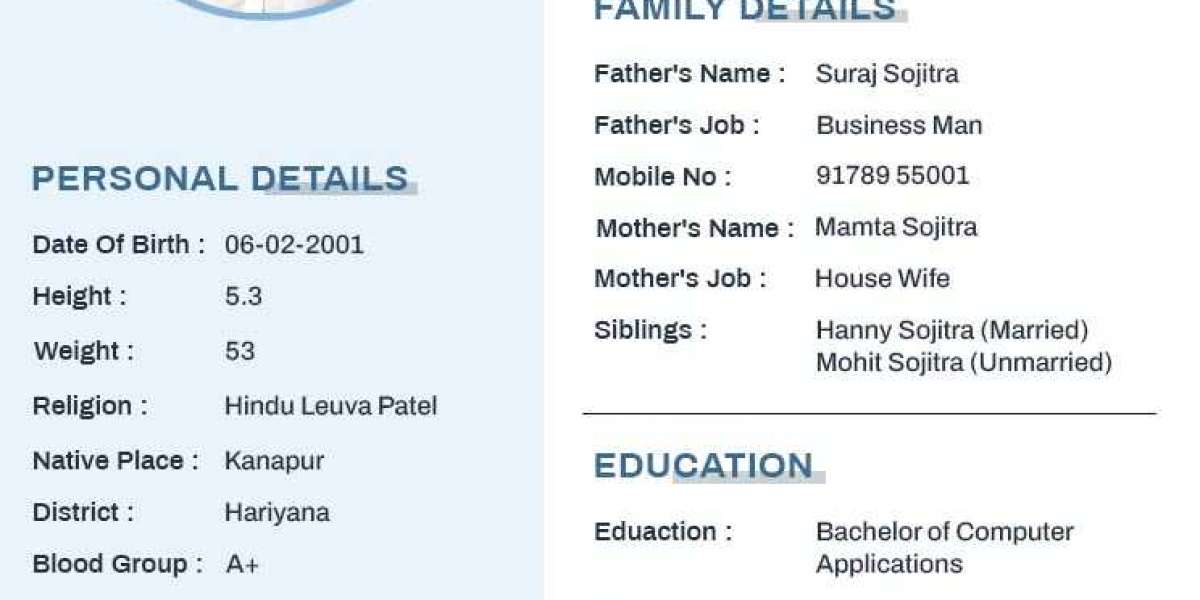This guide will walk you through everything you need to know about creating a perfect marriage biodata format. From personal details to family background, we will explore each section in depth, offering tips on how to present your information effectively and professionally.
What is a Marriage Biodata Format?
A marriage biodata format is a formal document that contains key information about an individual, usually with the intention of finding a suitable partner. It includes personal, professional, and family details, and may also touch on preferences like hobbies, religious beliefs, and expectations in a spouse. This format is particularly common in communities where arranged marriages are practiced and is often the first step in initiating marriage discussions between families.
Why is a Marriage Biodata Format Important?
The marriage biodata format serves as a structured way to present one’s profile in a clear and concise manner. It helps families quickly assess compatibility between two individuals based on factors like education, background, and values. By offering a standard format, it ensures that no critical information is overlooked and that the process of matchmaking can proceed smoothly and efficiently.
Key Elements of a Marriage Biodata Format
When crafting a marriage biodata format, certain sections are essential to provide a comprehensive overview of yourself. Let’s break down these elements:
1. Personal Information
The first section of the marriage biodata format should contain personal details, including:
- Name: Full name as it appears on official documents.
- Age/Date of Birth: Clearly mention your age and birth date to avoid any confusion.
- Height and Weight: Physical attributes are often included to provide a complete picture.
- Religion and Caste (if applicable): Mention your religious beliefs and caste, especially if these factors are important in your community.
- Languages Known: Mention the languages you speak fluently, as language compatibility can be important in marriage.
2. Educational Background
A well-structured marriage biodata format includes detailed information about your educational qualifications. This section should cover:
- Highest Degree Obtained: List your degrees, starting with the highest level of education.
- Institution Name and Year of Graduation: Mention the university or college you attended along with the graduation year.
- Professional Certifications: If applicable, include any additional certifications that highlight your expertise in your field.
3. Professional Details
Your professional status is another crucial aspect of your marriage biodata format. This section should highlight:
- Current Job Title: Clearly mention your job title and the organization you work for.
- Company Name and Industry: Provide the name of your employer and the industry you are associated with.
- Years of Experience: Outline your total years of experience in your field.
- Career Goals: A brief mention of your professional aspirations can be helpful for prospective families to understand your long-term plans.
4. Family Details
In arranged marriages, family background plays a vital role in the decision-making process. A detailed marriage biodata format includes:
- Father’s Name and Occupation: Mention your father’s name and current or previous occupation.
- Mother’s Name and Occupation: Include your mother’s name and occupation if applicable.
- Siblings: Provide information on your brothers and sisters, including their names, occupations, and marital status.
- Family Values: This is where you can briefly mention your family’s values, whether they are traditional, moderate, or liberal.
5. Contact Information
Your marriage biodata format should also have clear and easy-to-access contact information. This typically includes:
- Phone Number and Email Address: Provide both your phone number and a professional email address for easy communication.
- Residential Address: It’s common to include your current residential address, especially if it’s relevant to the discussions of future family settings.
Visit Now : invitation for satyanarayan pooja
Optional Sections in a Marriage Biodata Format
Apart from the essential sections, there are some optional sections you can include in your marriage biodata format to give a more well-rounded view of yourself.
1. Hobbies and Interests
Sharing your hobbies and interests allows the prospective partner and their family to gain insight into your personality. Whether you enjoy reading, traveling, sports, or cooking, this section highlights how you spend your leisure time.
2. Personal Beliefs and Values
In many cases, compatibility in values and beliefs plays a significant role in marriage decisions. This section can cover:
- Religious Practices: Mention how involved you are in religious practices if that is important to your family or community.
- Cultural Values: Discuss any cultural beliefs that play a key role in your life.
3. Partner Expectations
A well-drafted marriage biodata format often includes a section on what you are looking for in a life partner. Be realistic and respectful in this section, focusing on qualities that are meaningful to you:
- Personality Traits: Whether you value kindness, intelligence, or a sense of humor, mention the key traits you’re looking for in a spouse.
- Educational or Professional Preferences: If you have preferences regarding your partner’s education or career, clearly state them here.
- Lifestyle Choices: Briefly mention any lifestyle preferences, such as your thoughts on travel, living abroad, or maintaining a balance between career and family.
How to Format Your Marriage Biodata Professionally
To ensure your marriage biodata format is professional and visually appealing, follow these formatting tips:
1. Use a Clear Layout
Organize the document with clear headings and subheadings to make it easy to read. Ensure that each section flows smoothly into the next, and avoid cluttering the document with unnecessary information.
2. Keep it Simple and Concise
While it’s important to provide enough information, avoid overwhelming the reader with too many details. Be concise and to the point in each section.
3. Add a Professional Photo
Include a professional, recent photo in your marriage biodata format. Make sure the photo is clear and reflects your true personality.
4. Proofread for Accuracy
Before sending your marriage biodata format, double-check all details for accuracy. Ensure there are no spelling errors, and that your contact information is up to date.
Examples of Marriage Biodata Format Templates
There are many templates available for crafting a marriage biodata format, and you can choose one that best suits your style. Below are two common examples:
1. Simple Traditional Format
This format includes all essential sections like personal details, education, and family background, but keeps the design simple and straightforward, focusing on clarity and tradition.
2. Modern and Digital Format
With the rise of online matchmaking, many people prefer digital marriage biodata formats that can be shared via email or social media. These digital formats are often interactive and visually engaging, incorporating design elements like color schemes and personalized fonts.
Common Mistakes to Avoid in a Marriage Biodata Format
While creating your marriage biodata format, there are some common mistakes you should avoid:
1. Providing Incomplete Information
Ensure that every essential section is filled out completely, as missing information may lead to confusion or a poor impression.
2. Overloading the Document
Don’t try to include too much information or overly personal details. Focus on what’s necessary for the prospective family to know and leave out irrelevant details.
3. Unprofessional Photos
Make sure the photo you include is appropriate for the occasion. Avoid casual or group photos, and opt for a professional image that clearly shows your face.
Conclusion
A well-structured marriage biodata format is a critical part of the matchmaking process in arranged marriages. By presenting your personal, educational, and family details in a clear and concise manner, you increase your chances of finding a compatible partner. Make sure to include all essential sections, avoid common mistakes, and present yourself professionally. Whether you choose a traditional or modern template, the key is to create a biodata that reflects your personality and values.








